The Spatiotemporal Characteristics of Water Quality and Main Controlling Factors of Algal Blooms in Tai Lake, China
Abstract
:1. Introduction
2. Study Area
3. Methodology
3.1. Data Collection
3.2. 3D Water Environment Mathematical Model
3.3. Model Performance Assessment
3.4. LHS Uncertainty Analysis Method
3.5. Morris Sensitivity Analysis Method
4. Results and Discussion
4.1. Calibration and Validation of the 3D Model
4.2. Spatiotemporal Uncertainty Analysis
4.3. Sensitivity Analysis at Different Times
5. Conclusions
- (1)
- The 3D water environment mathematical model can play an effective role in water quality simulations of Tai Lake. The simulation accuracy of total phosphorus and total nitrogen is higher than that of Chl-a and dissolved oxygen, and the average error is less than 20%. The 3D Eco-lab model is suitable for research on large shallow lake water quality in other areas.
- (2)
- The results of the spatiotemporal uncertainty analysis show that Chl-a and TP are closely correlated in Tai Lake, as are TN and DO. This indicates that to prepare for the early warning and prevention of algal blooms, the change in TP concentration in Tai Lake should be monitored closely.
- (3)
- Based on the meteorological data in 2017, combined with our sensitivity analysis, we conclude that the algal bloom in 2017 is mainly related to the sudden change in climate and the high TP concentration. Therefore, controlling the TP concentration in Tai Lake is still the best method for the Chinese government to solve the problem of algal blooms.
Author Contributions
Funding
Conflicts of Interest
Appendix A
| Parameter | Definition | Assigned | Min | Max |
|---|---|---|---|---|
| mymg | Max growth rate phytoplankton | 2.1 | 1.5 | 2.5 |
| sep | Sedimentation rate < 2 m | 0.15 | 0.12 | 0.18 |
| seve | Sedimentation rate > 2 m | 0.1 | 0.08 | 0.12 |
| kdma | Death rate phytoplankton | 0.05 | 0.04 | 0.08 |
| kra | Oxygen reaeration constant | 3 | 1 | 5 |
| kmdm | Detritus C mineralization rate | 0.02 | 0.016 | 0.024 |
| pla | Light extinction constant phytoplankton | 20 | 16 | 24 |
| bla | Light extinction background constant | 0.456 | 0.365 | 0.547 |
| kmsc | Proportional factor for sediment respiration | 1 | 0.8 | 1.2 |
| kmsn | Proportional factor for N release from sediment | 0.3 | 0.24 | 0.36 |
| kmsp | Proportional factor for P release from sediment | 0.8 | 0.64 | 0.96 |
| mdo | Half-saturation constant | 5.5 | 4 | 6 |
| mdos | Half-saturation constant in sediment | 3.5 | 3 | 4 |
| ndo | Coefficient for oxygen dependency | 1.03 | 1 | 1.16 |
| tere | Temperature dependency for C mineralization | 1.04 | 1 | 1.16 |
| kmdn | Proportional factor for release of N from mineralization | 1 | 1 | 1.16 |
| kmdp | Proportional factor for release of P from mineralization | 1 | 1 | 1.16 |
| tetn | Temperature dependency sediment N release | 1.02 | 1 | 1.16 |
| tetp | Temperature dependency sediment P release | 1.02 | 1 | 1.16 |
| nrel | N-release under anoxic conditions | 0.02 | 0.015 | 0.025 |
| prel | P-release under anoxic conditions | 0.003 | 0.0024 | 0.0036 |
| ters | Temperature dependency sediment respiration | 1.02 | 1 | 1.16 |
| pnmi | Min. intracellular concentration of nitrogen | 0.08 | 0.06 | 0.14 |
| pnma | Max. intracellular concentration of nitrogen | 0.13 | 0.06 | 0.15 |
| ppmi | Min. intracellular concentration of phosphorous | 0.006 | 0.004 | 0.012 |
| ppma | Max. intracellular concentration of phosphorous | 0.08 | 0.06 | 0.15 |
| kc | Half-saturation concentration for phosphorus | 0.005 | 0.004 | 0.006 |
| kni | N uptake under limiting conditions | 0.15 | 0.1 | 0.2 |
| kpi | P uptake under limiting conditions | 0.008 | 0.004 | 0.012 |
| kpn | Half-saturation constant for N uptake | 0.2 | 0.16 | 0.24 |
| kpp | Half-saturation constant for P uptake | 0.02 | 0.016 | 0.024 |
| vm | Fraction of nutrients released at phytoplankton death | 0.1 | 0.08 | 0.12 |
| fac | Correction for dark reaction | 1.3 | 1.04 | 1.5 |
| alfaeu | Light saturation intensity | 25 | 20 | 30 |
| teti | Temperature dependency for light saturation intensity | 1.05 | 1 | 1.16 |
| epsi | Specification for nutrient saturation | 0.005 | 0.004 | 0.006 |
| vo | Production/consumption relative to carbon | 3.5 | 2.8 | 4.2 |
| lcg | Lassiter temp constant | 0.16 | 0.12 | 0.2 |
| optg | Optimum growth temperature | 28 | 20 | 32 |
References
- Wei, L.; Zhu, N.; Liu, X.; Zheng, H.; Xiao, K.; Huang, Q.; Liu, H.; Cai, M. Application of Hi-throat/Hi-volume SPE technique in assessing organophosphorus pesticides and their degradation products in surface water from Tai Lake, east China. J. Environ. Manag. 2022, 305, 114346. [Google Scholar] [CrossRef] [PubMed]
- Zhang, H.; Yang, L.; Li, Y.; Wang, C.; Zhang, W.; Wang, L.; Niu, L. Pollution gradients shape the co-occurrence networks and interactions of sedimentary bacterial communities in Taihu Lake, a shallow eutrophic lake. J. Environ. Manag. 2022, 305, 114380. [Google Scholar] [CrossRef] [PubMed]
- Khan, M.Y.A.; Wen, J. Evaluation of physicochemical and heavy metals characteristics in surface water under anthropogenic activities using multivariate statistical methods, Garra River, Ganges Basin, India. Environ. Eng. Res. 2020, 26, 200280. [Google Scholar] [CrossRef]
- Schnedler-Meyer, N.A.; Andersen, T.K.; Hu, F.R.S.; Bolding, K.; Nielsen, A.; Trolle, D. Water Ecosystems Tool (WET) 0.1.0—A new generation of flexible aquatic ecosystem model. Geosci. Model Dev. 2022, 1–24. [Google Scholar] [CrossRef]
- Ghobadi, A.; Cheraghi, M.; Sobhanardakani, S.; Lorestani, B.; Merrikhpour, H. Groundwater quality modeling using a novel hybrid data-intelligence model based on gray wolf optimization algorithm and multi-layer perceptron artificial neural network: A case study in Asadabad Plain, Hamedan, Iran. Environ. Sci. Pollut. Res. 2022, 29, 8716–8730. [Google Scholar] [CrossRef] [PubMed]
- Zou, R.; Wu, Z.; Zhao, L.; Elser, J.J.; Yu, Y.; Chen, Y.; Liu, Y. Seasonal algal blooms support sediment release of phosphorus via positive feedback in a eutrophic lake: Insights from a nutrient flux tracking modeling. Ecol. Model. 2020, 416, 108881. [Google Scholar] [CrossRef]
- Xu, R.; Pang, Y.; Hu, Z. Sensitivity analysis of external conditions based on the MARS-Sobol method: Case study of Tai Lake, China. Water Supply 2021, 21, 723–735. [Google Scholar] [CrossRef]
- Xia, W.; Shoemaker, C.; Akhtar, T.; Nguyen, M.-T. Efficient parallel surrogate optimization algorithm and framework with application to parameter calibration of computationally expensive three-dimensional hydrodynamic lake PDE models. Environ. Model. Softw. 2021, 135, 104910. [Google Scholar] [CrossRef]
- Nielsen, A.; Schmidt Hu, F.R.; Schnedler-Meyer, N.A.; Bolding, K.; Andersen, T.K.; Trolle, D. Introducing QWET—A QGIS-plugin for application, evaluation and experimentation with the WET model. Environ. Model. Softw. 2021, 135, 104886. [Google Scholar] [CrossRef]
- Chou, Q.; Nielsen, A.; Andersen, T.K.; Hu, F.; Chen, W.; Cao, T.; Ni, L.; Søndergaard, M.; Johansson, L.S.; Jeppesen, E.; et al. The impacts of extreme climate on summer-stratified temperate lakes: Lake Søholm, Denmark, as an example. Hydrobiologia 2021, 848, 3521–3537. [Google Scholar] [CrossRef]
- Janssen, A.B.G.; Teurlincx, S.; Beusen, A.H.W.; Huijbregts, M.A.J.; Rost, J.; Schipper, A.M.; Seelen, L.M.S.; Mooij, W.M.; Janse, J.H. PCLake+: A process-based ecological model to assess the trophic state of stratified and non-stratified freshwater lakes worldwide. Ecol. Model. 2019, 396, 23–32. [Google Scholar] [CrossRef]
- Wei, Y.; Yuanxi, L.; Yu, L.; Mingxiang, X.; Liping, Z.; Qiuliang, D. Impacts of rainfall intensity and urbanization on water environment of urban lakes. Ecohydrol. Hydrobiol. 2020, 20, 513–524. [Google Scholar] [CrossRef]
- Li, D.; Hu, L.; Peng, X.; Xiao, N.; Zhao, H.; Liu, G.; Liu, H.; Li, K.; Ai, B.; Xia, H.; et al. A proposed artificial intelligence workflow to address application challenges leveraged on algorithm uncertainty. iScience 2022, 25, 103961. [Google Scholar] [CrossRef]
- Andersen, T.K.; Bolding, K.; Nielsen, A.; Bruggeman, J.; Jeppesen, E.; Trolle, D. How morphology shapes the parameter sensitivity of lake ecosystem models. Environ. Model. Softw. 2021, 136, 104945. [Google Scholar] [CrossRef]
- Wang, Z.; Akbar, S.; Sun, Y.; Gu, L.; Zhang, L.; Lyu, K.; Huang, Y.; Yang, Z. Cyanobacterial dominance and succession: Factors, mechanisms, predictions, and managements. J. Environ. Manag. 2021, 297, 113281. [Google Scholar] [CrossRef]
- Sin, G.; Gernaey, K.V.; Neumann, M.B.; van Loosdrecht, M.C.; Gujer, W. Global sensitivity analysis in wastewater treatment plant model applications: Prioritizing sources of uncertainty. Water Res. 2011, 45, 639–651. [Google Scholar] [CrossRef]
- Zameer, A.; Muneeb, M.; Mirza, S.M.; Raja, M.A.Z. Fractional-order particle swarm based multi-objective PWR core loading pattern optimization. Ann. Nucl. Energy 2020, 135, 106982. [Google Scholar] [CrossRef]
- Jiang, L.; Li, Y.; Zhao, X.; Tillotson, M.R.; Wang, W.; Zhang, S.; Sarpong, L.; Asmaa, Q.; Pan, B. Parameter uncertainty and sensitivity analysis of water quality model in Lake Taihu, China. Ecol. Model. 2018, 375, 1–12. [Google Scholar] [CrossRef]
- Gao, X.; Cui, Y.; Hu, J.; Xu, G.; Wang, Z.; Qu, J.; Wang, H. Parameter extraction of solar cell models using improved shuffled complex evolution algorithm. Energy Convers. Manag. 2018, 157, 460–479. [Google Scholar] [CrossRef]
- Qian, G.; Mahdi, A. Sensitivity analysis methods in the biomedical sciences. Math. Biosci. 2020, 323, 108306. [Google Scholar] [CrossRef]
- Plaas, H.E.; Paerl, H.W. Toxic Cyanobacteria: A Growing Threat to Water and Air Quality. Env. Sci Technol. 2021, 55, 44–64. [Google Scholar] [CrossRef] [PubMed]
- Jordan, M.; Millinger, M.; Thrän, D. Robust bioenergy technologies for the German heat transition: A novel approach combining optimization modeling with Sobol’ sensitivity analysis. Appl. Energy 2020, 262, 114534. [Google Scholar] [CrossRef]
- Liu, W.; Ding, L. Global sensitivity analysis of influential parameters for excavation stability of metro tunnel. Autom. Constr. 2020, 113, 103080. [Google Scholar] [CrossRef]
- Zhou, S.; Guo, X.; Zhang, Q.; Dias, D.; Pan, Q. Influence of a weak layer on the tunnel face stability—Reliability and sensitivity analysis. Comput. Geotech. 2020, 122, 103507. [Google Scholar] [CrossRef]
- Zhang, Q. Global bounded solutions to a Keller–Segel system with singular sensitivity. Appl. Math. Lett. 2020, 107, 106397. [Google Scholar] [CrossRef]
- Li, Y.; Tang, C.; Zhu, J.; Pan, B.; Anim, D.O.; Ji, Y.; Yu, Z.; Acharya, K. Parametric uncertainty and sensitivity analysis of hydrodynamic processes for a large shallow freshwater lake. Hydrol. Sci. J. 2015, 60, 1078–1095. [Google Scholar] [CrossRef]
- Yi, X.; Zou, R.; Guo, H. Global sensitivity analysis of a three-dimensional nutrients-algae dynamic model for a large shallow lake. Ecol. Model. 2016, 327, 74–84. [Google Scholar] [CrossRef]
- Wiltshire, K.H.; Tanner, J.E. Comparing maximum entropy modelling methods to inform aquaculture site selection for novel seaweed species. Ecol. Model. 2020, 429, 109071. [Google Scholar] [CrossRef]
- Dige, N.; Diwekar, U. Efficient sampling algorithm for large-scale optimization under uncertainty problems. Comput. Chem. Eng. 2018, 115, 431–454. [Google Scholar] [CrossRef]
- Shahnewaz, M.; Alam, M.S. Genetic algorithm for predicting shear strength of steel fiber reinforced concrete beam with parameter identification and sensitivity analysis. J. Build. Eng. 2020, 29, 101205. [Google Scholar] [CrossRef]
- King, D.M.; Perera, B.J.C. Morris method of sensitivity analysis applied to assess the importance of input variables on urban water supply yield—A case study. J. Hydrol. 2013, 477, 17–32. [Google Scholar] [CrossRef]
- Cosenza, A.; Mannina, G.; Vanrolleghem, P.A.; Neumann, M.B. Global sensitivity analysis in wastewater applications: A comprehensive comparison of different methods. Environ. Model. Softw. 2013, 49, 40–52. [Google Scholar] [CrossRef]
- Zilverberg, C.J.; Angerer, J.; Williams, J.; Metz, L.J.; Harmoney, K. Sensitivity of diet choices and environmental outcomes to a selective grazing algorithm. Ecol. Model. 2018, 390, 10–22. [Google Scholar] [CrossRef]
- Huang, J.; Gao, J. An improved Ensemble Kalman Filter for optimizing parameters in a coupled phosphorus model for lowland polders in Lake Taihu Basin, China. Ecol. Model. 2017, 357, 14–22. [Google Scholar] [CrossRef]
- Hu, W. A review of the models for Lake Taihu and their application in lake environmental management. Ecol. Model. 2016, 319, 9–20. [Google Scholar] [CrossRef]
- Wang, Y.; Yang, G.; Li, B.; Wang, C.; Su, W. Measuring the zonal responses of nitrogen output to landscape pattern in a flatland with river network: A case study in Taihu Lake Basin, China. Environ. Sci. Pollut. Res. 2022, 29, 34624–34636. [Google Scholar] [CrossRef]
- Guo, J.; Wang, L.; Yang, L.; Deng, J.; Zhao, G.; Guo, X. Spatial-temporal characteristics of nitrogen degradation in typical Rivers of Taihu Lake Basin, China. Sci. Total Environ. 2020, 713, 136456. [Google Scholar] [CrossRef]
- Feng, T.; Wang, C.; Wang, P.; Qian, J.; Wang, X. How physiological and physical processes contribute to the phenology of cyanobacterial blooms in large shallow lakes: A new Euler-Lagrangian coupled model. Water Res. 2018, 140, 34–43. [Google Scholar] [CrossRef]
- Xu, R.; Pang, Y.; Hu, Z.; Kaisam, J.P. Dual-Source Optimization of the “Diverting Water from the Yangtze River to Tai Lake (DWYRTL)” Project Based on the Euler Method. Complexity 2020, 2020, 3256596. [Google Scholar] [CrossRef]
- Sheikholeslami, R.; Razavi, S. Progressive Latin Hypercube Sampling: An efficient approach for robust sampling-based analysis of environmental models. Environ. Model. Softw. 2017, 93, 109–126. [Google Scholar] [CrossRef]
- Ren, J.; Zhang, W.; Yang, J. Morris Sensitivity Analysis for Hydrothermal Coupling Parameters of Embankment Dam: A Case Study. Math. Probl. Eng. 2019, 2019, 2196578. [Google Scholar] [CrossRef] [Green Version]
- Ranjbar, M.H.; Hamilton, D.P.; Etemad-Shahidi, A.; Helfer, F. Individual-based modelling of cyanobacteria blooms: Physical and physiological processes. Sci. Total Environ. 2021, 792, 148418. [Google Scholar] [CrossRef] [PubMed]
- Zhang, S.; Yi, Q.; Buyang, S.; Cui, H.; Zhang, S. Enrichment of bioavailable phosphorus in fine particles when sediment resuspension hinders the ecological restoration of shallow eutrophic lakes. Sci. Total Environ. 2020, 710, 135672. [Google Scholar] [CrossRef]
- Pang, M.; Xu, R.; Hu, Z.; Wang, J.; Wang, Y. Uncertainty and Sensitivity Analysis of Input Conditions in a Large Shallow Lake Based on the Latin Hypercube Sampling and Morris Methods. Water 2021, 13, 1861. [Google Scholar] [CrossRef]
- Cao, H.; Han, L.; Li, L. A deep learning method for cyanobacterial harmful algae blooms prediction in Taihu Lake, China. Harmful Algae 2022, 113, 102189. [Google Scholar] [CrossRef] [PubMed]
- Ke, Z.; Xie, P.; Guo, L. Ecological restoration and factors regulating phytoplankton community in a hypertrophic shallow lake, Lake Taihu, China. Acta Ecol. Sin. 2019, 39, 81–88. [Google Scholar] [CrossRef]
- Xu, D.; Wang, Y.; Liu, D.; Wu, D.; Zou, C.; Chen, Y.; Cai, Y.; Leng, X.; An, S. Spatial heterogeneity of food web structure in a large shallow eutrophic lake (Lake Taihu, China): Implications for eutrophication process and management. J. Freshw. Ecol. 2019, 34, 231–247. [Google Scholar] [CrossRef] [Green Version]
- Xu, H.; Xu, M.; Li, Y. Characterization, origin and aggregation behavior of colloids in eutrophic shallow lake. Water Res. 2018, 142, 11. [Google Scholar] [CrossRef]
- Janssen, A.B.G.; de Jager, V.C.L.; Janse, J.H.; Kong, X.; Liu, S.; Ye, Q.; Mooij, W.M. Spatial identification of critical nutrient loads of large shallow lakes: Implications for Lake Taihu (China). Water Res. 2017, 119, 276–287. [Google Scholar] [CrossRef]
- Hetherington, A.L.; Schneider, R.L.; Rudstam, L.G.; Gal, G.; DeGaetano, A.T.; Walter, M.T. Modeling climate change impacts on the thermal dynamics of polymictic Oneida Lake, New York, United States. Ecol. Model. 2015, 300, 1–11. [Google Scholar] [CrossRef]
- Nizzoli, D.; Welsh, D.T.; Viaroli, P. Denitrification and benthic metabolism in lowland pit lakes: The role of trophic conditions. Sci. Total Environ. 2020, 703, 134804. [Google Scholar] [CrossRef] [PubMed]
- Zhang, T.; Ban, X.; Wang, X. Analysis of nutrient transport and ecological response in Honghu Lake, China by using a mathematical model. Sci. Total Environ. 2017, 575, 418–428. [Google Scholar] [CrossRef] [PubMed]
- Khan, A.; Khan, A.; Khan, F.; Shah, L.; Rauf, A.U.; Badrashi, Y.; Khan, W.; Khan, J. Assessment of the Impacts of Terrestrial Determinants on Surface Water Quality at Multiple Spatial Scales. Pol. J. Environ. Stud. 2021, 30, 2137–2147. [Google Scholar] [CrossRef]
- Khan, A.U.; Jiang, J.; Wang, P.; Zheng, Y. Influence of watershed topographic and socio-economic attributes on the climate sensitivity of global river water quality. Environ. Res. Lett. 2017, 12, 104012. [Google Scholar] [CrossRef] [Green Version]
- Wang, M.; Strokal, M.; Burek, P.; Kroeze, C.; Ma, L.; Janssen, A.B.G. Excess nutrient loads to Lake Taihu: Opportunities for nutrient reduction. Sci. Total Environ. 2019, 664, 865–873. [Google Scholar] [CrossRef]
- Liu, X.; Feng, J.; Wang, Y. Chlorophyll a predictability and relative importance of factors governing lake phytoplankton at different timescales. Sci. Total Environ. 2019, 648, 472–480. [Google Scholar] [CrossRef]
- Terry, J.A.; Sadeghian, A.; Lindenschmidt, K.-E. Modelling Dissolved Oxygen/Sediment Oxygen Demand under Ice in a Shallow Eutrophic Prairie Reservoir. Water 2017, 9, 131. [Google Scholar] [CrossRef] [Green Version]
- Wu, T.; Qin, B.; Brookes, J.D.; Yan, W.; Ji, X.; Feng, J. Spatial distribution of sediment nitrogen and phosphorus in Lake Taihu from a hydrodynamics-induced transport perspective. Sci. Total Environ. 2019, 650, 1554–1565. [Google Scholar] [CrossRef]
- Wang, C.; Peng, M.; Xia, G. Sensitivity analysis based on Morris method of passive system performance under ocean conditions. Ann. Nucl. Energy 2020, 137, 107067. [Google Scholar] [CrossRef]
- Khan, A.; Jiang, J.; Sharma, A.; Wang, P.; Khan, J. How Do Terrestrial Determinants Impact the Response of Water Quality to Climate Drivers?—An Elasticity Perspective on the Water–Land–Climate Nexus. Sustainability 2017, 9, 2118. [Google Scholar] [CrossRef] [Green Version]
- Deng, J.; Paerl, H.W.; Qin, B.; Zhang, Y.; Zhu, G.; Jeppesen, E.; Cai, Y.; Xu, H. Climatically-modulated decline in wind speed may strongly affect eutrophication in shallow lakes. Sci. Total Environ. 2018, 645, 1361–1370. [Google Scholar] [CrossRef] [PubMed]
- Deng, Y.; Zhang, Y.; Li, D.; Shi, K.; Zhang, Y. Temporal and Spatial Dynamics of Phytoplankton Primary Production in Lake Taihu Derived from MODIS Data. Remote Sens. 2017, 9, 195. [Google Scholar] [CrossRef]
- Chao, J.Y.; Zhang, Y.M.; Kong, M.; Zhuang, W.; Wang, L.M.; Shao, K.Q.; Gao, G. Long-term moderate wind induced sediment resuspension meeting phosphorus demand of phytoplankton in the large shallow eutrophic Lake Taihu. PLoS ONE 2017, 12, e0173477. [Google Scholar] [CrossRef] [PubMed]
- Liang, Z.; Chen, H.; Wu, S.; Zhang, X.; Yu, Y.; Liu, Y. Exploring Dynamics of the Chlorophyll alpha-Total Phosphorus Relationship at the Lake-Specific Scale: A Bayesian Hierarchical Model. Water Air Soil Pollut. 2018, 229, 21. [Google Scholar] [CrossRef]
- Wang, J.; Li, X.; Lu, L.; Fang, F. Parameter sensitivity analysis of crop growth models based on the extended Fourier Amplitude Sensitivity Test method. Environ. Model. Softw. 2013, 48, 171–182. [Google Scholar] [CrossRef]
- Liang, H.; Gao, S.; Hu, K. Global sensitivity and uncertainty analysis of the dynamic simulation of crop N uptake by using various N dilution curve approaches. Eur. J. Agron. 2020, 116, 126044. [Google Scholar] [CrossRef]
- Khan, M.Y.A.; ElKashouty, M.; Bob, M. Impact of rapid urbanization and tourism on the groundwater quality in Al Madinah city, Saudi Arabia: A monitoring and modeling approach. Arab. J. Geosci. 2020, 13, 922. [Google Scholar] [CrossRef]
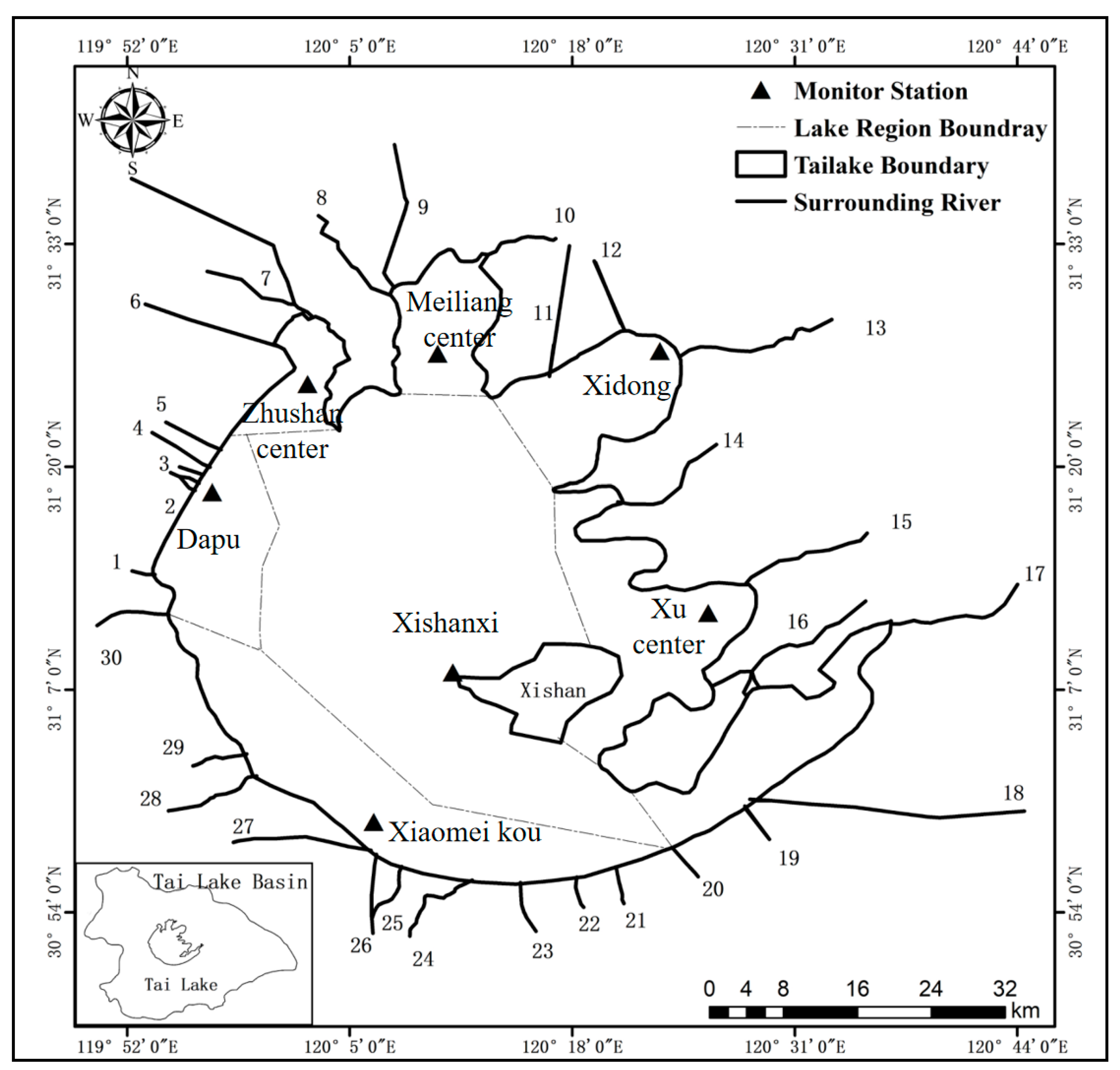
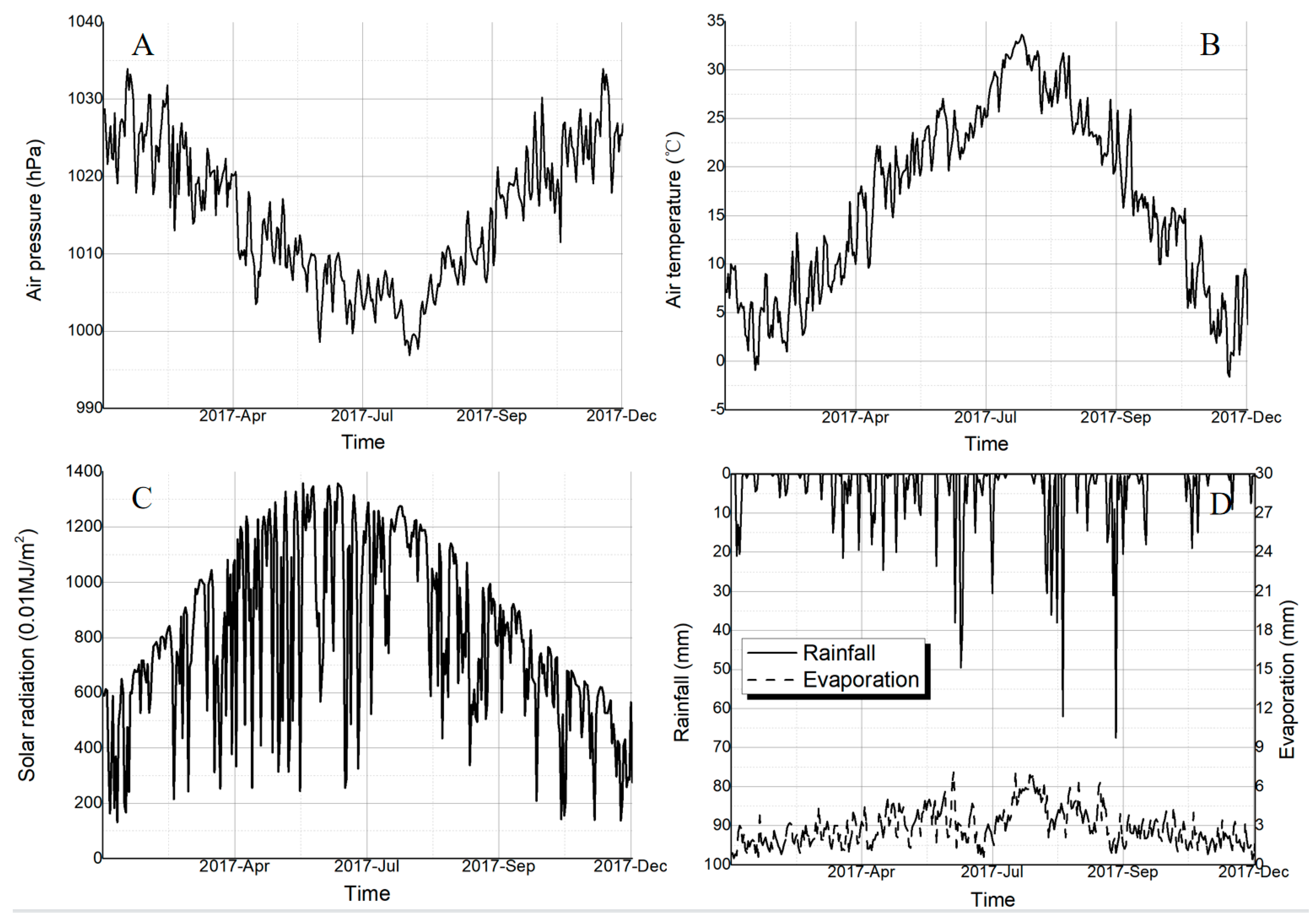
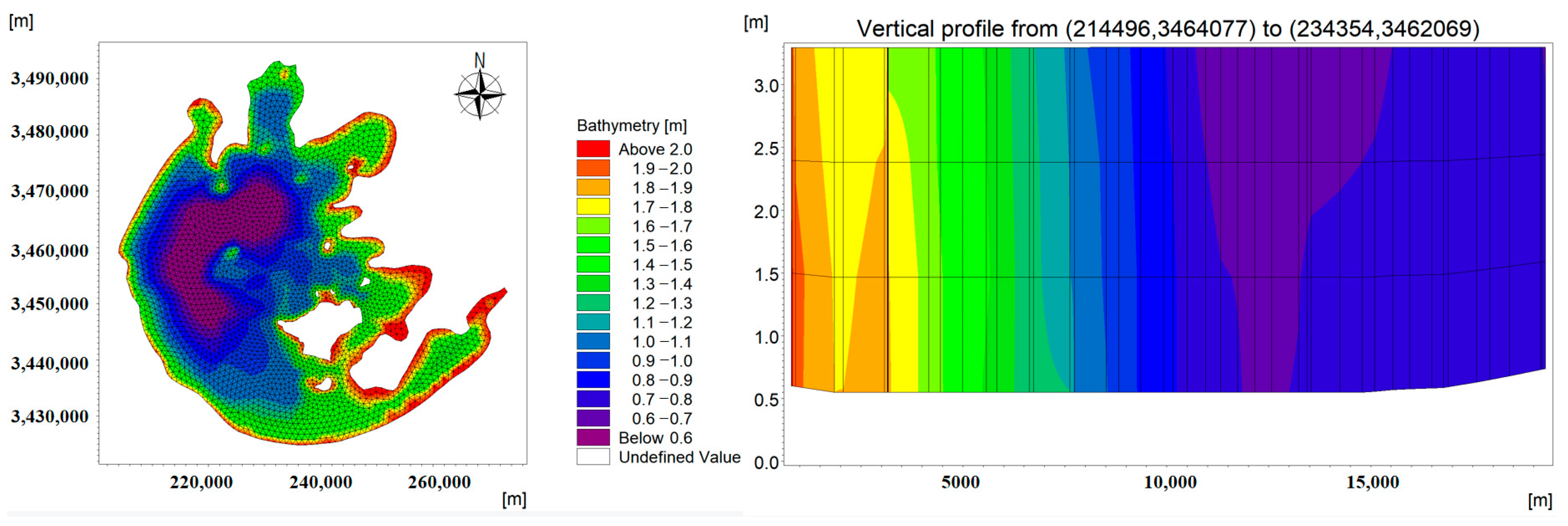
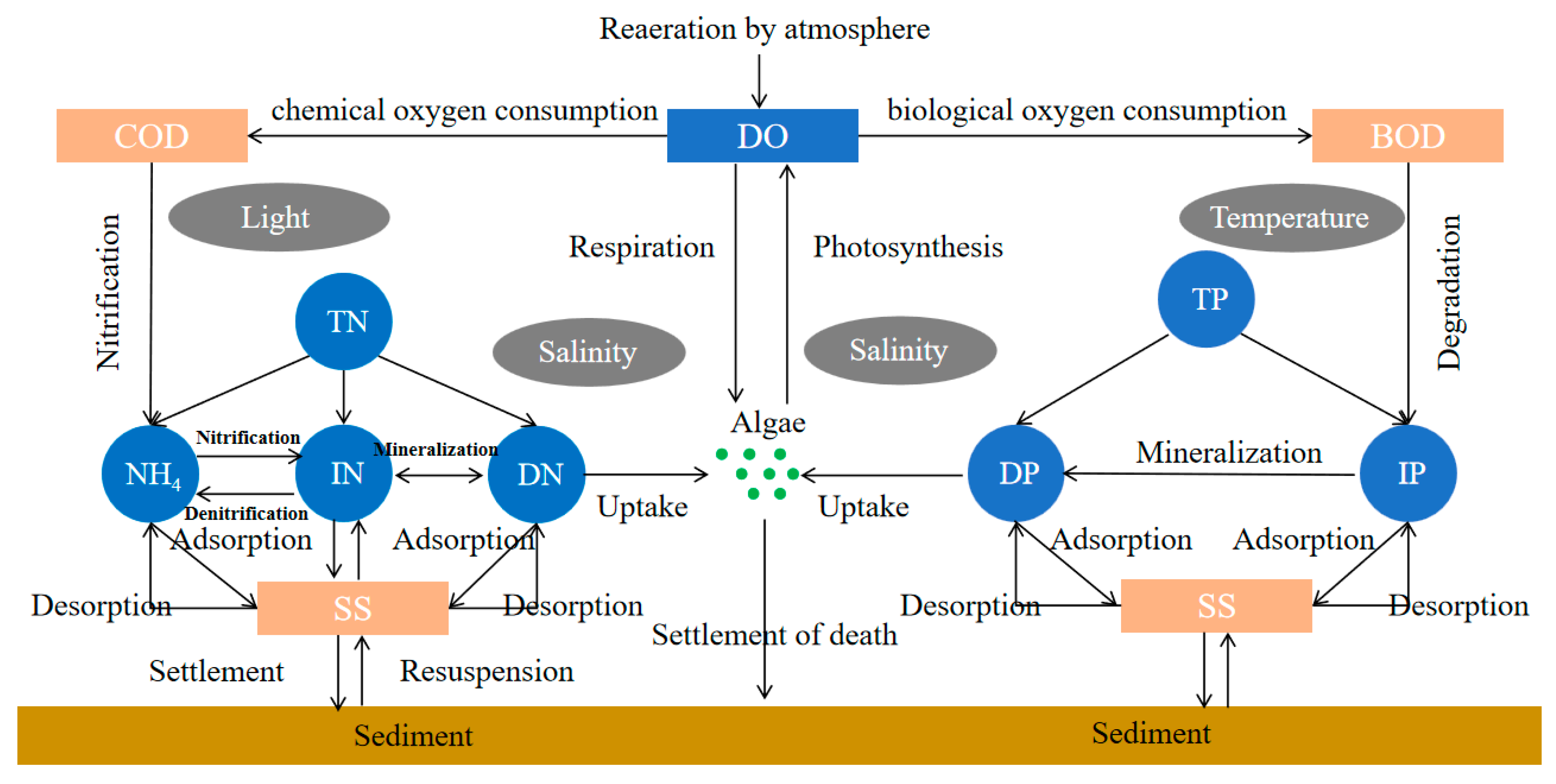

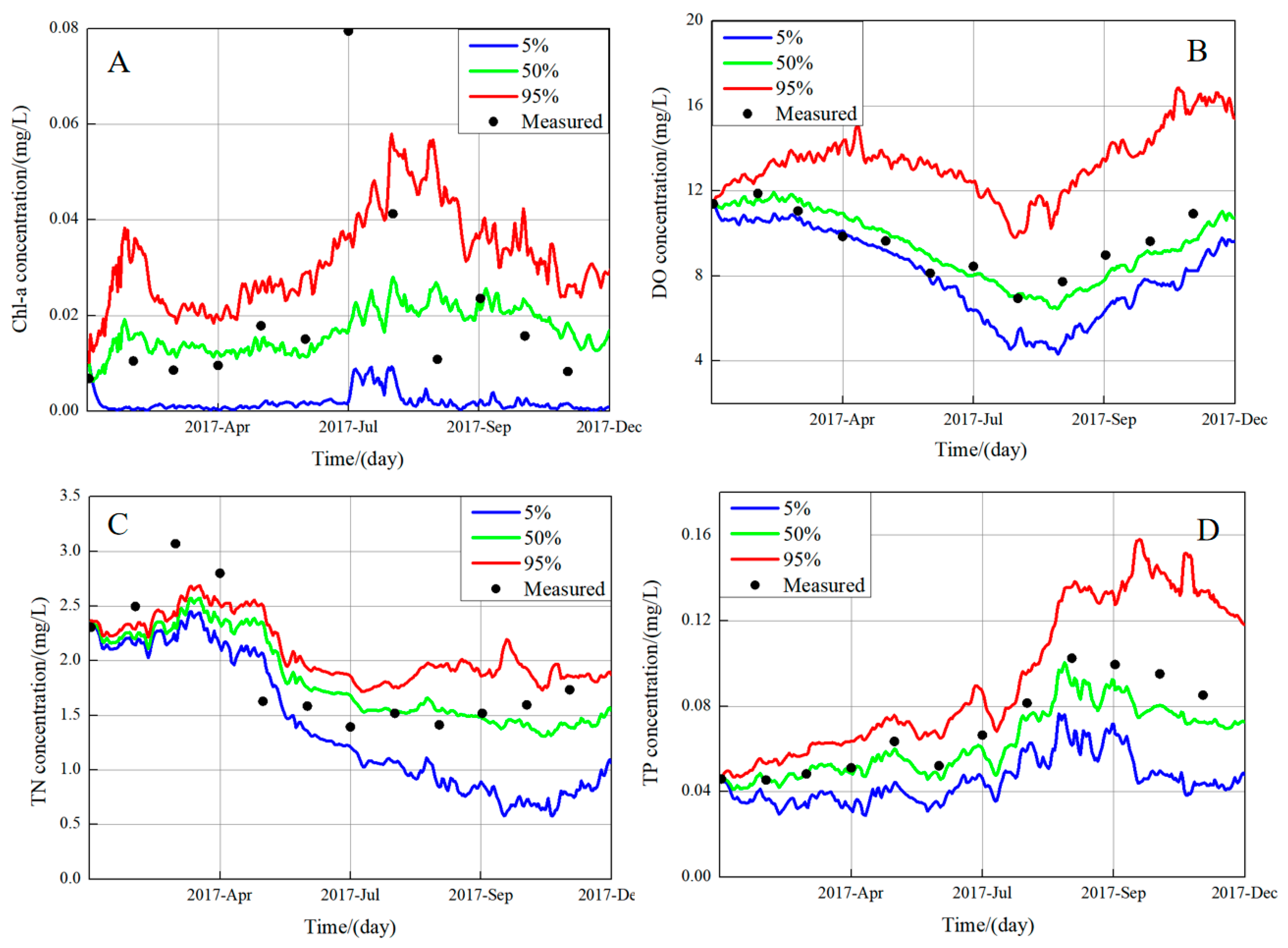
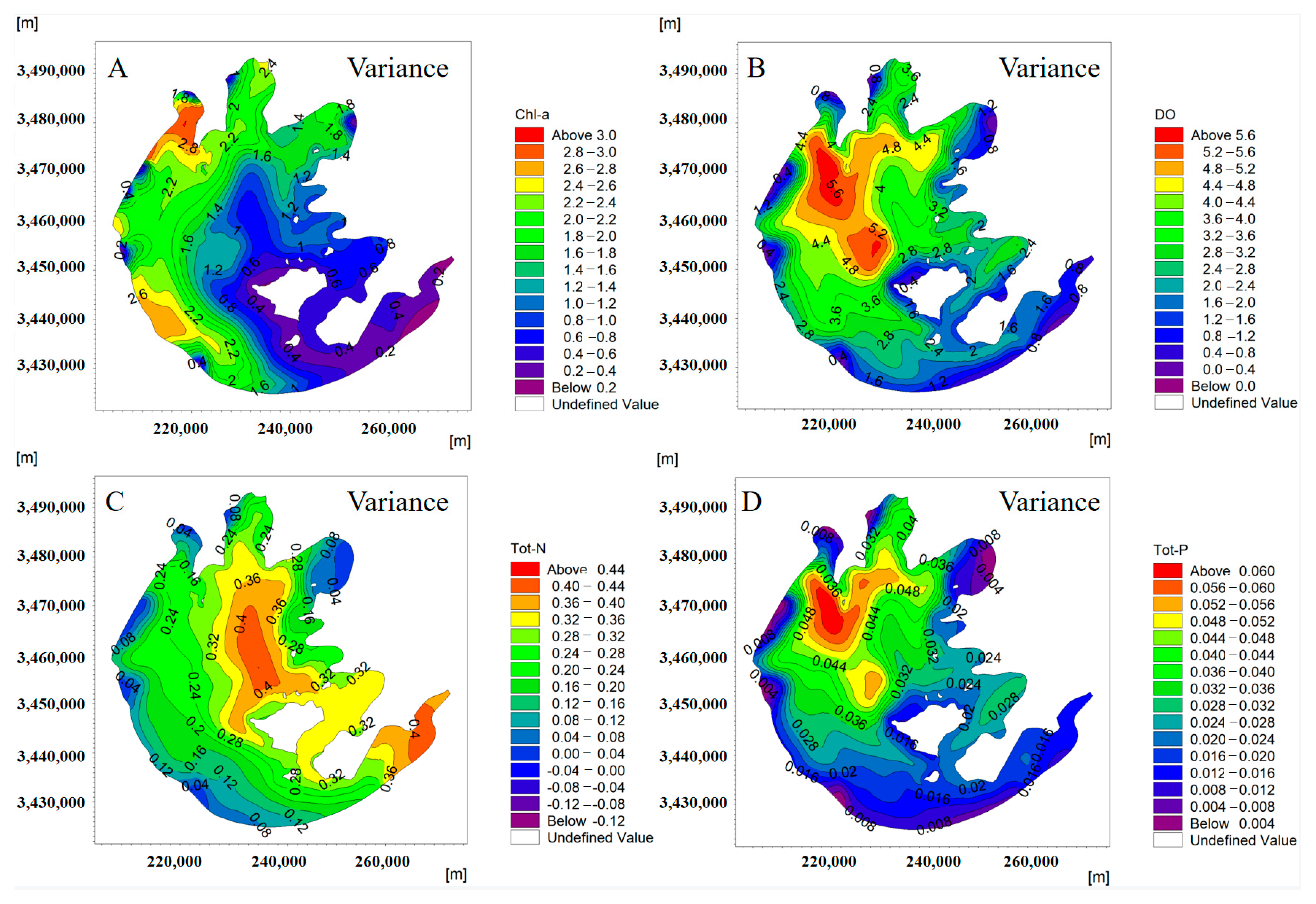
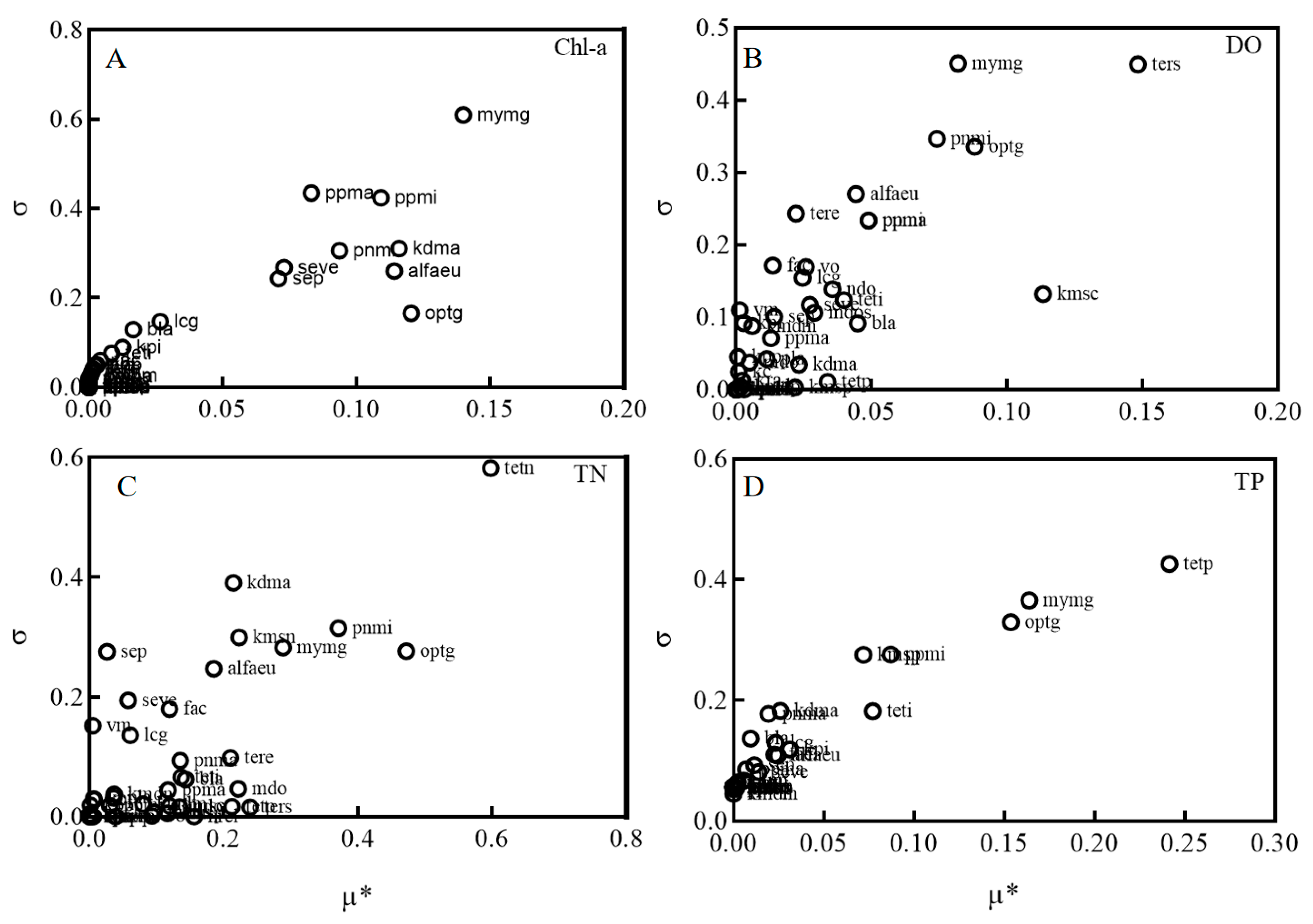
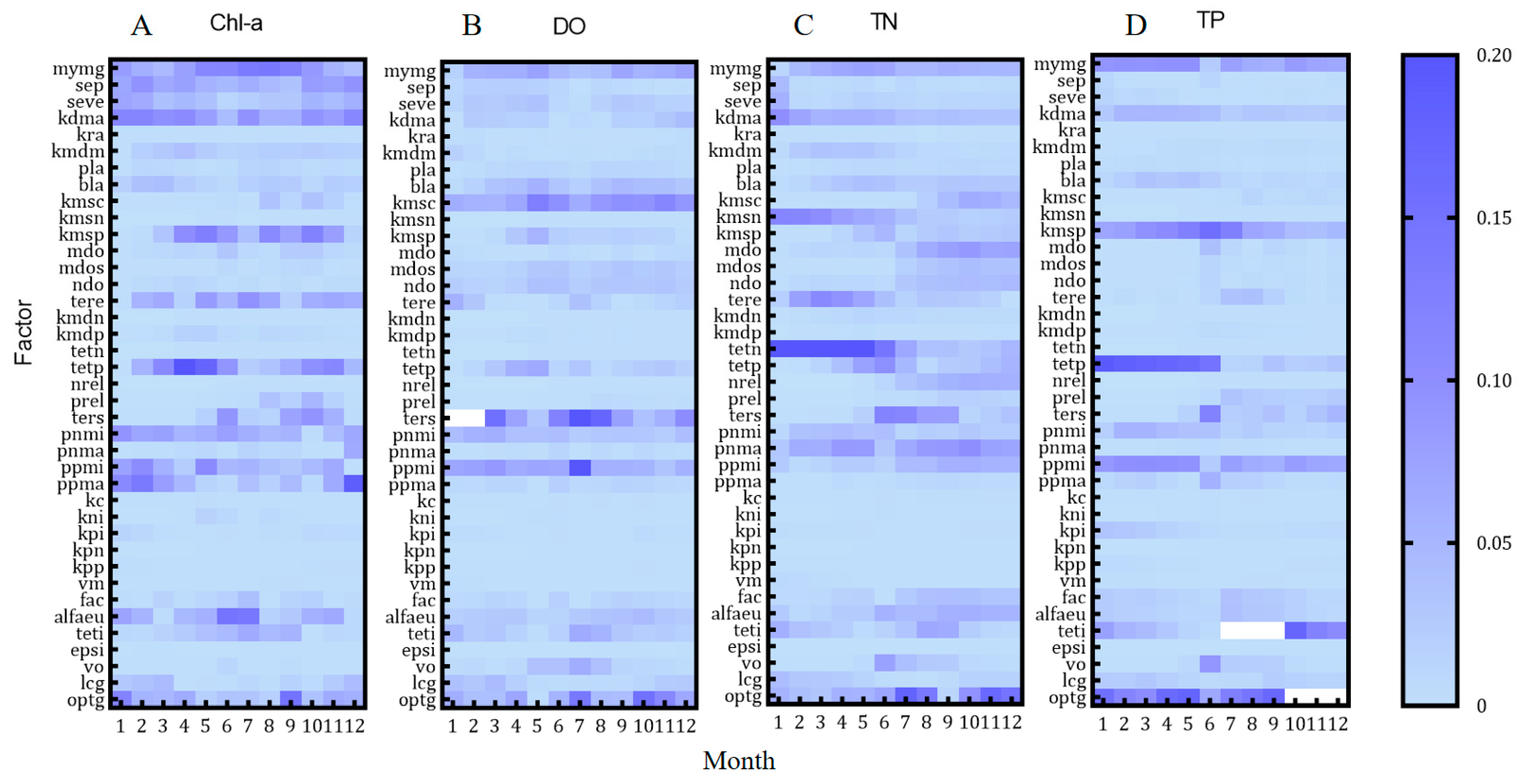
| Method | Name | Advantages | Limitations |
|---|---|---|---|
| Uncertainty analysis methods | Monte Carlo |
|
|
| LHS |
|
| |
| GLUE |
|
| |
| Sensitivity analysis methods | Morris |
|
|
| SRRC |
|
| |
| Sobol |
|
| |
| EFAST |
|
| |
| RSA |
|
|
| Indicators | Time | RMSE | MRE | R2 | NSE |
|---|---|---|---|---|---|
| TP | Calibration | 0.012 | 0.010 | 0.945 | 0.864 |
| Validation | 0.018 | 0.014 | 0.921 | 0.801 | |
| TN | Calibration | 0.182 | 0.159 | 0.956 | 0.992 |
| Validation | 0.209 | 0.188 | 0.915 | 0.965 | |
| Chl-a | Calibration | 0.005 | 0.004 | 0.865 | 0.988 |
| Validation | 0.007 | 0.006 | 0.831 | 0.925 | |
| DO | Calibration | 0.915 | 0.756 | 0.901 | 0.993 |
| Validation | 0.955 | 0.821 | 0.869 | 0.990 |
Publisher’s Note: MDPI stays neutral with regard to jurisdictional claims in published maps and institutional affiliations. |
© 2022 by the authors. Licensee MDPI, Basel, Switzerland. This article is an open access article distributed under the terms and conditions of the Creative Commons Attribution (CC BY) license (https://creativecommons.org/licenses/by/4.0/).
Share and Cite
Xu, R.; Pang, Y.; Hu, Z.; Hu, X. The Spatiotemporal Characteristics of Water Quality and Main Controlling Factors of Algal Blooms in Tai Lake, China. Sustainability 2022, 14, 5710. https://doi.org/10.3390/su14095710
Xu R, Pang Y, Hu Z, Hu X. The Spatiotemporal Characteristics of Water Quality and Main Controlling Factors of Algal Blooms in Tai Lake, China. Sustainability. 2022; 14(9):5710. https://doi.org/10.3390/su14095710
Chicago/Turabian StyleXu, Ruichen, Yong Pang, Zhibing Hu, and Xiaoyan Hu. 2022. "The Spatiotemporal Characteristics of Water Quality and Main Controlling Factors of Algal Blooms in Tai Lake, China" Sustainability 14, no. 9: 5710. https://doi.org/10.3390/su14095710
APA StyleXu, R., Pang, Y., Hu, Z., & Hu, X. (2022). The Spatiotemporal Characteristics of Water Quality and Main Controlling Factors of Algal Blooms in Tai Lake, China. Sustainability, 14(9), 5710. https://doi.org/10.3390/su14095710






